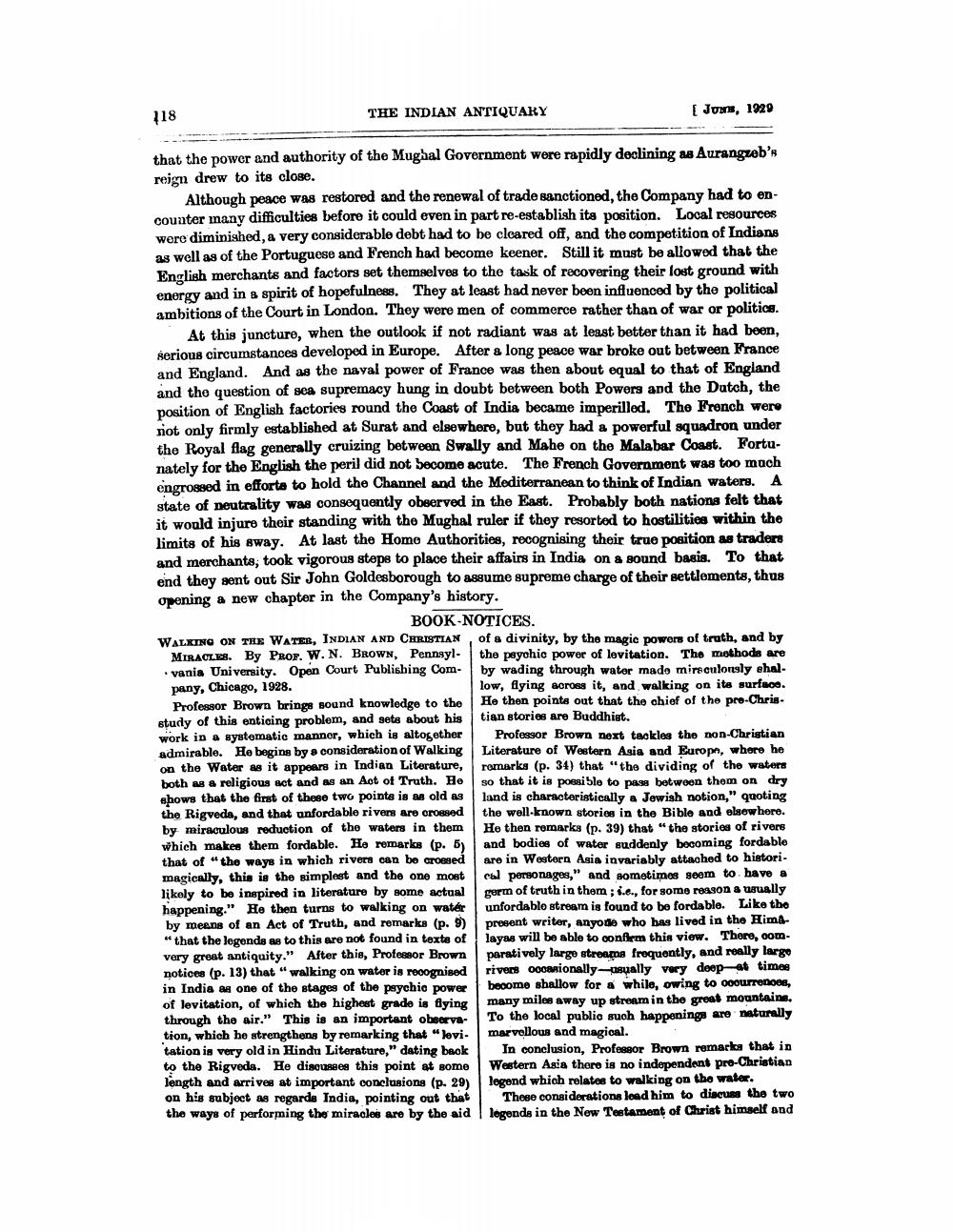________________
118
THE INDIAN ANTIQUARY
( JUMA, 1929
that the power and authority of the Mughal Government were rapidly declining as Aurangzeb's reign drew to its close.
Although peace was restored and the renewal of trade sanctioned, the Company had to encounter many difficulties before it could even in part re-establish its position. Local resources were diminished, a very considerable debt had to be cleared off, and the competition of Indians as well as of the Portuguese and French had become keener. Still it must be allowed that the English merchants and factors set themselves to the task of recovering their lost ground with energy and in a spirit of hopefulness. They at least had never been influenced by the political ambitions of the Court in London. They were men of commerce rather than of war or politics.
At this juncture, when the outlook if not radiant was at least better than it had been, serious circumstances developed in Europe. After a long peace war broke out between France and England. And as the naval power of France was then about equal to that of England and the question of sea supremacy hung in doubt between both Powers and the Dutch, the position of English factories round the coast of India became imperilled. The French were not only firmly established at Surat and elsewhere, but they had a powerful squadron under the Royal flag generally cruizing between Swally and Mahe on the Malabar Coast. Fortunately for the English the peril did not become acute. The French Government was too much engrossed in efforts to hold the Channel and the Mediterranean to think of Indian waters. A state of neutrality was consequently observed in the East. Probably both nationa felt that it would injure their standing with the Mughal ruler if they resorted to hostilities within the limits of his sway. At last the Home Authorities, recognising their true position as traders and merchants, took vigorous steps to place their affairs in India on & sound basis. To that end they sent out Sir John Goldesborough to assume supreme charge of their settlements, thus Opening a new chapter in the Company's history.
BOOK-NOTICES. WALKING ON THE WATER, INDIAN AND CHRISTIAN, of a divinity, by the magic powers of truth, and by
MIRACLES. By Pror. W. N. BROWN, Pennsyl- the psychic power of levitation. The methods are .vania University. Open Court Publishing Com- by wading through water mado mirsenlongly ehalpany, Chicago, 1928.
low, flying across it, and walking on its surface. Professor Brown brings sound knowledge to the He thon points out that the chief of the pro-Chris. study of this enticing problem, and sets about his tian stories are Buddhist. work in a systematic manner, which is altogether Professor Brown next tackles the non-Christian admirable. He begins by a consideration of Walking Literature of Western Asia and Europa, where he on the Water as it appears in Indian Literature, remarks (p. 34) that "the dividing of the waters both as a religious act and as an Act of Truth. He so that it is possible to pass between them on dry shows that the first of these two pointa is a old as land is characteristically a Jewish notion," quoting the Rigveda, and that unfordable rivers are crossed the well-known stories in the Bible and elsewhere. by miraculous reduction of the waters in them He then romarks (p. 39) that "the stories of rivers which makes them fordable. He remarks (p. 5) and bodies of water suddenly becoming fordable that of the ways in which rivers can be crossed are in Western Asia invariably attached to historimagically, this is the simplest and the one most cal personages," and sometimes seem to have a likely to be inspired in literature by some actual germ of truth in them ; i.e., for some reason a usually happening." He then turns to walking on water unfordablo stream is found to be fordable. Like tho by means of an Act of Truth, and remarks (p. 9) present writer, anyone who has lived in the Hims" that the legends as to this are not found in texte of layas will be able to confirm this view. There, oomvery great antiquity." After this, Professor Brown | paratively large streams frequently, and really large notices (p. 13) that "walking on water is rooognised rivers occasionally usually very deep at times in India as one of the stages of the paychio power
become shallow for a while, owing to ooourrences, of levitation, of which the highest grade is flying
many miles away up stream in the great mountains. through the air." This is an important observa- To the local public suoh happenings are naturally tion, which he strengthens by remarking that "Jovi
marvellous and magical. tation is very old in Hindu Literature," dating back In conclusion, Professor Brown remarloa that in to the Rigveda. He discusses this point at some | Western Asia there is no independent pro-Christian length and arrives at important conclusions (p. 29) legend which relates to walking on the water. on his subject as regarda India, pointing out that These considerations lead him to discuss the two the ways of performing the miracles are by the aid legends in the New Testament of Christ himself and




